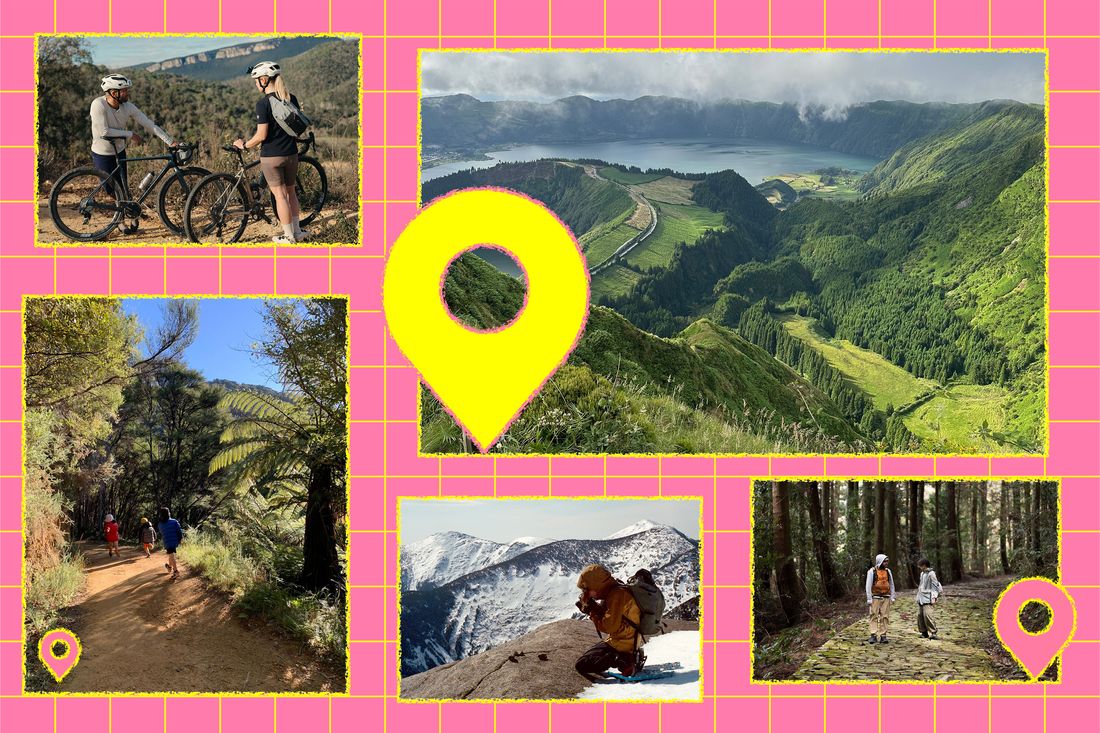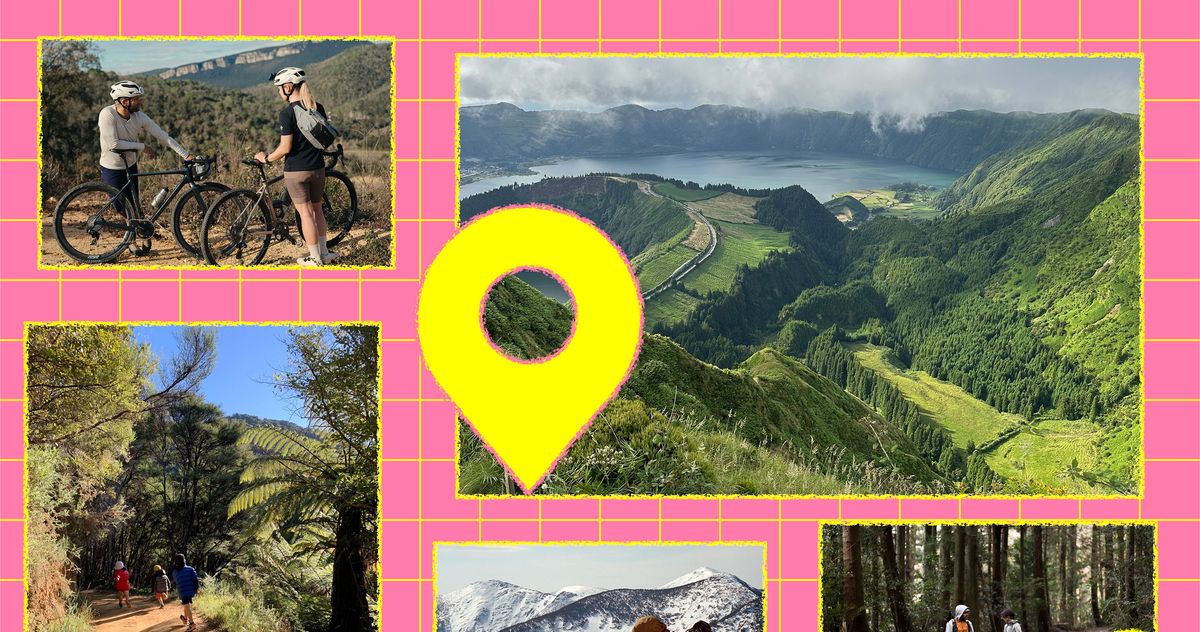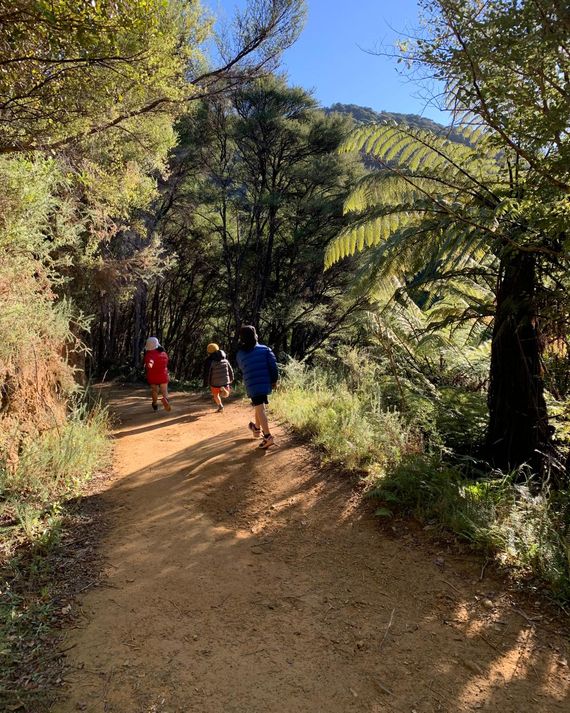
Photo-Illustration: The Strategist; Photos Courtesy: Tessa Forrestt, Frances Shoemack, Blair Kemp and Reggie McCafferty, Craig Mod, Sean Greene and Javier Fernandez
In our long-running Strategist travel rubric, Steal My Vacation, we ask experts to tell us every detail about their all-time favorite adventures. But for this special feature, we’ve flipped the challenge. Here, adventurous, outdoorsy people with absurdly good taste provide condensed itineraries of trips in a sought-after category: hiking and camping destinations that take you into (somewhat-undiscovered) nature, but with excellent food and drinks nearby.
Sifnos, Greece
“You can explore almost the entire island of Sifnos by foot. I stayed with a group of friends at an Airbnb about a 30-minute walk from town and used AllTrails to find hikes to beaches that were accessible only by walking or boat. There’s a great beach called Vathi with a ceramics shop that’s wrapped around the cove — you can swim to it if the tide is high. And then you can hike from Vathi Beach to Fikiada Beach, which is very remote. We went at sunrise, and there was no one else around. The best time of year to go is when the local radio station, RadioActive, hosts its Full Moon Street Party in August. The entire island broadcasts it, so as you’re walking around, every single shop or car is playing the same songs.” —Chelsea Rizzo, co-founder of Hikerkind
France, Italy, and Switzerland
“The window for hiking in the Alps is very small, from late June to early September, and you should book your accommodation at least a year in advance. Rifugio Bonatti is the most famous refuge on the circuit, so reserve it first and plan your trip around that. The second-most-competitive place to stay is the hamlet of Les Chapieux, because it’s small, so beds fill up quickly. For a night of luxury, I ended up staying at the Grand Hotel Courmayeur Mont Blanc. But there is a range of options, from camping to private rooms, and lots of the dorms are really clean and nice. I did the whole circuit in seven days because it’s very flexible. You can skip entire legs if you want and take the bus or train between towns. I love that there’s always camaraderie on the trails. You can talk to people from all over the world, and if you need something, there’s always someone there to help you.” —Irene Kim, stylist
Central Essex County
“We’ve done two winter backcountry trips where we stayed in the Adirondack Mountain Club huts near Keene Valley. The huts are an easy 3.5-mile hike from the parking area, and they have a little bit of heat in winter as well as a propane stove for cooking. If you go in February, there will still be snow, so bringing snowshoes is required. It’s more extreme than a normal hiking trip, but because you’re sleeping in huts, you won’t need a four-season tent or zero-degree sleeping bag. There are all sorts of day hiking, anywhere from a 15-mile loop to a six-mile out-and-back up to one of the higher peaks nearby.” —Blair Kemp and Reggie McCafferty, editors at Amateurs magazine
The Azores, Portugal
“The island of São Miguel is only a five- or six-hour flight from New York. We stayed for two nights on the east side and two nights on the west, doing day hikes to different spots. It was easy to rent a car, and it takes only a few hours to drive across the whole island. The Praia de Lagoa do Fogo circuit is the best hike I’ve ever been on, and I’ve hiked in Peru and Iceland. It was four hours out and back, and the landscape changes constantly. Dark volcanic soil contrasts with bright-green plants, redwood forests, and lakes. My partner and I loved it so much that we’re considering getting married there.” —Tessa Forrest, art director at Atmos magazine
Cumbria, Northwest England
“In the Lake District, you can hike up a mountain or a fell, which is a lower mountain, and you can see views that stretch for miles. The landscape is gentle and compact. It’s incredible. To get there from London, take the train to Oxenholme or Penrith, which are the main stations that give access to the lakes. You’ll need to rent a car at the station when you arrive as there aren’t many good transit options from there. The boutique hotel Another Place has a swimming pool that looks out on the mountains. I also love staying at a pub like the Hare & Hounds Inn. I suggest doing a two- or three-hour hike in the morning, then spending the rest of the day exploring towns and shops. Grasmere is cute with a famous gingerbread place where all the ladies still wear bonnets. Their gingerbread recipe is locked in a vault.” —Grace Cook, sports-culture writer
Tohoku Region, Japan
“The Michinoku Coastal Trail is a newer Japanese hiking trail that’s inspired by famous long-distance trails in America like the Pacific Crest Trail and the Appalachian Trail. It was created to bring tourism to northeastern Honshu, which was heavily impacted by the 2011 tsunami. You’re forest-hiking by the beach and then popping out into tiny little villages. I hiked for 50 miles over a span of four days, staying in salaryman-style hotels that felt untouched since the 1980s. But there are also fantastic campgrounds with wooden platforms for tents. You can rough it, stay in hotels, or do a mix of both.” —Graham Hiemstra, founder of Field Mag
Chugoku Region, Japan
“For a non-touristy experience, get the train to Yamaguchi City and then walk the Hagi Okan mountain path to Hagi City. You can do it in two days, staying overnight in Hayashiya Ryokan in Sasanami, which is above an old tofu shop at the midway point. It’s worth spending time exploring the gardens and temples of Yamaguchi City and neighboring Yuda before you start walking north. The route is really well maintained; there’s a little bit of road-walking, but for the most part it’s pleasant and historical and sections are lined with Edo-era paving stones. Hagi has great restaurants and a fun little jazz café.” —Craig Mod, photographer and author of Things Become Other Things
Catalonia, Spain
“Hiking in Spain is cheaper than in Southern California or Colorado in terms of food and accommodation, and there are no trail or parking permits that are an obstacle to get around. Our first stop was Tiana, a hilly town that’s about a 30-minute drive from Barcelona. There’s a fire-lookout trail where you can view the Pyrenees. After that, I suggest spending a few days in Girona, where you can rent bikes and cycle directly to trailheads. There are historic ruins, mountains, and waterfalls everywhere you go. Then visit the tiny mountainside climbing town of Abella, which has sweeping snowcap views. It’s worth ducking into Andorra nearby because it has low sales tax. Spaniards go there for the skiing.” —Caroline Brammer, creative marketing manager at Gossamer Gear
Southern Utah
“In Utah’s famous national parks like Zion and Bryce Canyon, the trails are crowded, parking is an issue, and you’ll have to make hiking reservations way in advance. So instead, drive an hour outside any big park and camp for free on the public lands surrounding it. There’ll be no one around, and no permits are required. We do this with our kids every spring and fall, spending our days climbing into amazing narrow slot canyons and rappelling down rock faces. For your first time canyoneering, definitely hire a local guide who can advise on the right equipment and how to use it. The website Canyoneering USA has lots of maps and ideas for where to go, as does the app Road Trip Ryan.” —Tyson White, creative director and founder of SPC/LST
Long Beach Peninsula, Washington State
“The natural coastline in the Pacific Northwest is really beautiful, and it offers a bounty of experiences in nature. You’re on the edge of civilization, which feels quite cool. Yet it’s also a fun place to spend time outdoors with a young family, and it’s within easy access of bigger cities like Seattle or Portland. You can camp in state parks or at the Snow Peak Campfield. Or, for a funkier experience, you could stay in a converted Airstream at the Sou’wester Lodge. Cape Disappointment State Park has a really accessible trail system that allows you to hike to forts from World War II, and Leadbetter Point State Park has lots of easy walking with views of the Pacific Ocean on one side and Willapa Bay on the other. Summer out there is insane, and the weather is still beautiful in October.” —Michael Anderson, brand manager at Snow Peak USA
Patagonia, Chile
“We went to the Torres del Paine National Park and then down to Patagonia National Park with the company Explora. Patagonia National Park is currently being renewed by Rewilding Chile. They’re doing something unique and spectacular: putting the land back into its wild form. The terrain is absolutely exquisite, and Patagonia is an iconic place for people who enjoy walking and hiking. Explora has lodges in both places, and they’re quite luxurious. They even have cold plunges in Torres del Paine. Each morning you can tell their guides what kind of hike you want to do and the level of difficulty, and they’ll pack a delicious meal to bring along.” —Libby DeLana, creative director and founder of This Morning Walk
South Island, New Zealand
“The five-day Abel Tasman tramp (Kiwi for ‘hike’) follows the coast, so you can get dropped off or picked up by water taxi at any point. We did three nights, and my sister came and met us by boat for one of our days of hiking. You can stay in huts the whole way rather than carrying tents. The huts are fun and communal with kids playing together and parents cooking together. The phone reception can be spotty, so it’s a good time to unplug. Kaiteriteri is a stunning beach town basically right at the start of the track that’s a good place to stay before or after the hike. And the region of Nelson is a foodie haven with excellent wine, cheese, mushrooms, and truffles. I suggest carrying a cask of wine to pass around.” —Frances Shoemack, founder of Abel fragrances
Coastal hiking on the South Island of New Zealand.
Photo: Courtesy Frances Shoemack
Thank you for subscribing and supporting our journalism.
If you prefer to read in print, you can also find this article in the June 30, 2025, issue of
New York Magazine.
Want more stories like this one? Subscribe now
to support our journalism and get unlimited access to our coverage.
If you prefer to read in print, you can also find this article in the June 30, 2025, issue of
New York Magazine.
Actually good deals, smart shopping advice, and exclusive discounts.
Vox Media, LLC Terms and Privacy Notice
The Strategist is designed to surface useful, expert recommendations for things to buy across the vast e-commerce landscape. Every product is independently selected by our team of editors, whom you can read about here. We update links when possible, but note that deals can expire and all prices are subject to change.

